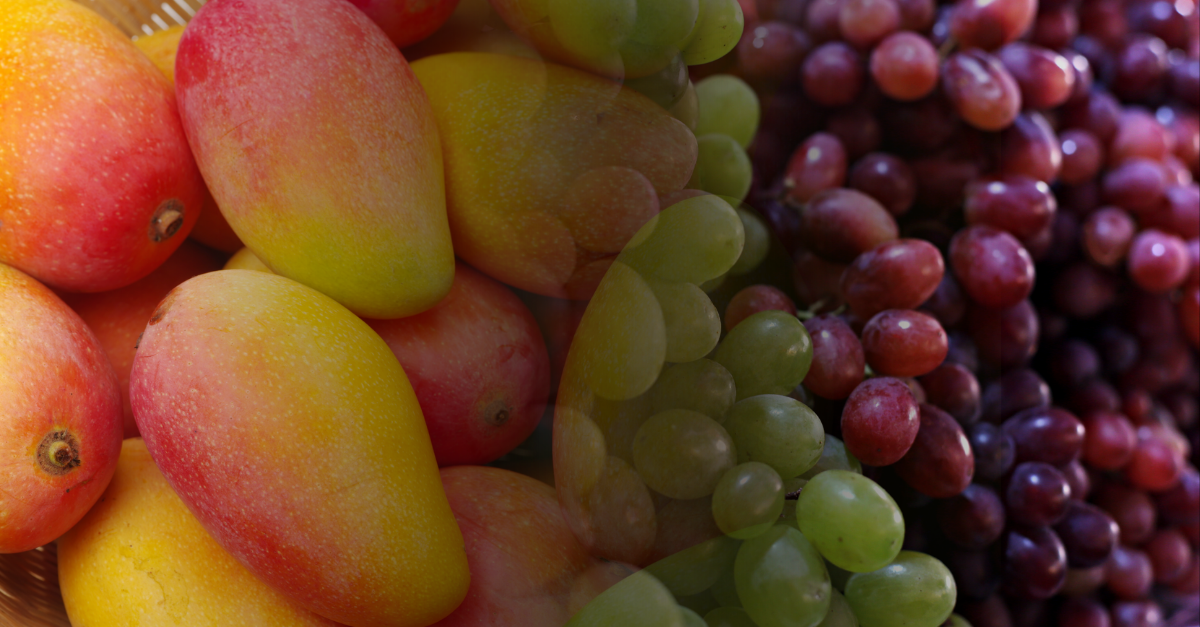
Mango and grapes represent 32% of fruit exports in 2020
Dec, 16, 2020 Posted by Ruth HollardWeek 202052
Mango and grape are two fruits that are ripe at year-end so are used for year-end family dinners. But these fruits are not only pleasing to the Brazilian palate; international demand for mangos and grapes is growing.
Data from DataLiner show that in the first ten months of 2020, mangos represented 24.1% of the fruits exported by Brazil. In the same period last year, the representation was slightly lower, 22%. The grape had a stable representation among the fruits exported by the country from January to October 2020: 8.6% against 8.7% in these months of 2019.
Grape exports peak between September and November, with a greater volume exported in October. Mangoes are exported practically year-round but with irregular volumes, as 58% of shipments are concentrated in the months of September, October, and November.
Seasonality of Mango and Grape Exports | 2017-2019
Source: DataLiner
Export logistics
As expected, the ports in the Northeast lead the exports of the two fruits, since they are mostly produced in the São Francisco Valley region. See below the participation of each port in the exports of the two fruits:
Main Mango- and Grape-Exporting Ports | Jan to Oct 2020 | TEU
Source: DataLiner
Among shipowners, CMA CGM leads export activities, transporting 41% of the volume exported from January 2017 to December 2019, followed by Hapag Lloyd (22%), Hamburg-Sud (18%), MSC (12 %), Marfret (5%), and Maersk Line (2%).
At the beginning of the fruit season, in September, Porto do Pecém started to receive the navigation line that connects Porto do Pecém with Mediterranean Sea ports for the second season in a row with the exclusive purpose of exporting fruit. The line is part of the WMED service, operated since last year by Mediterranean Shipping Company (MSC), with the following route:
Spain: Valencia (9 days); Barcelona (11 days);
Italy: Genova (13 days); Livorno (14 days) and Gioia Tauro (16 days).
According to MSC, this is also the only service with a direct stopover between a port in northeastern Brazil and Italy. The route meets the growing demand of fruit farmers who export part of their production to European countries, especially melon, produced in Ceará and Rio Grande do Norte; and mango and grapes, produced in the São Francisco River Valley.
Destinations
Europe is the main destination for Brazilian mangoes and grapes, importing 80% of the volume, followed by the United States, with 19%, and Asia with 1%. The Netherlands leads the European countries, and in 2020 received a volume 10% higher than that of 2019 (January to October) Check below:
Main destinations for Mango and Grape Exports | Jan to Oct 2019-2020 | TEU
| wdt_ID | País | 2019 | 2020 | Diff. % |
|---|---|---|---|---|
| 1 | NETHERLANDS | 8196 | 9.030 | 10% |
| 2 | UNITED STATES | 4136 | 4.871 | 18% |
| 3 | SPAIN | 2298 | 2.910 | 27% |
| 4 | UNITED KINGDOM | 2136 | 2.788 | 31% |
| 5 | RUSSIAN FEDERATION | 292 | 332 | 14% |
| 6 | GERMANY, FEDERAL REPUBLIC | 142 | 180 | 27% |
| 7 | IRELAND | 74 | 110 | 49% |
| 8 | NORWAY | 42 | 22 | -48% |
| 9 | UNITED ARAB EMIRATES | 32 | 26 | -19% |
| 10 | ITALY | 46 | 8 | -82% |
| 11 | OTHERS | 77 | 50 | -35% |
Source: DataLiner (To request a DataLiner demo click here)
Perspectives
According to CEPEA (the center for advanced studies in applied economics), from Esalq / USP, despite the initial fears, the Covid-19 pandemic brought little negative impact to Brazilian fruit exports. In volume, all the main exported fruits exceeded the average shipments of the last five years – and most even registered a performance superior to that observed in 2019, which had already been considered a good year.
For the agency, exports benefited from heated demand (in view of the appeal of healthy eating) and problems in some countries related to pandemic-related and productive issues. In addition, the dollar appreciated against the real so this also favored shipments, as it makes Brazilian products more attractive in the foreign market. The high US currency allowed exporters to lower the average price (in dollars), while still making a good profit in reais, even during unusual shipment periods. Brazil, in general, managed to maintain its supply of fruits, which stimulated exports to the European Union. This, in turn, kept the demand for fresh fruits and vegetables steady during the pandemic.
According to the executive director of ABRAFRUTAS (the Brazilian association of fruit and derivative export producers), Eduardo Brandão, next year Brazilian fruits are expected to be exported more to the Arab countries. The main fruits shipped to the Middle East and Asia are usually melons, grapes, mangoes, and Tahiti lemons, according to the association’s data.
“There is a great expectation of growth in fruit exports to the Middle East bloc (Saudi Arabia, Bahrain, and the United Arab Emirates) and for the Asian continent, especially China and South Korea. Our fruits are high quality and are highly appreciated by these countries”, said Brandão..
-
Other Logistics
Nov, 07, 2023
0
Santos City Calls For Studies on Export Processing Zones Implementation
-
Grains
Jul, 13, 2021
0
Brazil exports a record 45.6 million bags of coffee in the 2020/21 harvest
-
Other Cargo
Apr, 08, 2020
0
Import taxes waived on another 41 products used in fight against coronavirus
-
Ports and Terminals
Aug, 31, 2020
0
Record volumes of conilon coffee exported via Vitória port


